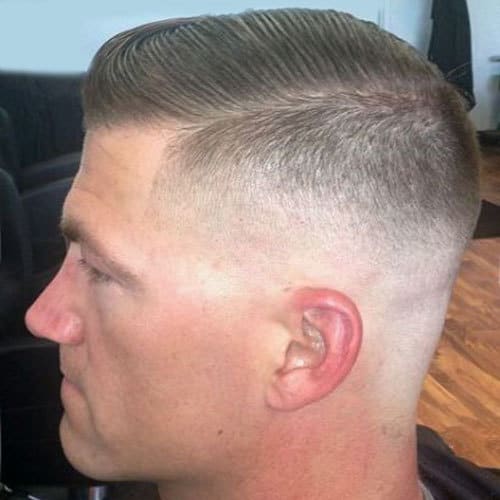The Regulation Cut: What It Is If you're looking for a classic and timeless haircut that exudes confidence and a touch of military style, the regulation cut might be the perfect choice for you. This iconic hairstyle has been popular for decades and continues to be favored by men of all ages. In this article, we'll delve into the ins and outs of the regulation cut, explore its history, and provide you with some styling tips to help you achieve the perfect look. So, grab your comb and let's dive into the world of the regulation cut! 1. The History Behind the Regulation Cut The regulation cut has its roots in the military, where it was originally known as the "Ivy League cut" due to its popularity among Ivy League college students. This clean and neat haircut was initially adopted by cadets and officers as a part of their dress code, symbolizing discipline and professionalism. Over time, the regulation cut transcended its military origins and became a widely embraced hairstyle for men in all walks of life. 2. Achieving the Perfect Regulation Cut To achieve the perfect regulation cut, you'll need to find a skilled barber who is well-versed in this specific style. The key characteristics of this haircut include a tapered back and sides with shorter hair at the crown, creating a clean and crisp appearance. It's essential to communicate your desired length and style with your barber to ensure they capture the essence of the regulation cut accurately. 3. Styling Tips for the Regulation Cut Once you've got a fresh regulation cut, maintaining its sharp and polished look is relatively straightforward. Here are a few styling tips to help you rock your new haircut: a. Use a good quality pomade or wax to add texture and hold to your hair. Apply it sparingly, focusing on the crown and the front of your hair to achieve a sleek and stylish finish. b. Regular trims are crucial to keep your regulation cut looking sharp. Visit your barber every four to six weeks to maintain the desired length and shape. c. Experiment with different hairstyles within the regulation cut family. From classic variations like the high and tight to more modern takes like the textured regulation cut, there are plenty of options to suit your personal style. 4. Top 15 Regulation Haircuts in 2023 If you're curious about the latest trends and variations of the regulation cut, we've compiled a list of the top 15 regulation haircuts for 2023. Get inspired by these stylish options and find the perfect one that suits your face shape and personal preferences. 1. The Classic Regulation Cut: A timeless look that never goes out of style. 2. The High and Tight: A popular military-inspired variation with a high fade and a clean, tight look. 3. The Textured Regulation Cut: Add some flair to your haircut with texturizing techniques and a modern twist. 4. The Side-Parted Regulation Cut: Comb your hair to the side for a sophisticated and dapper appearance. 5. The Undercut Regulation Cut: Combine the elegance of the regulation cut with an edgier undercut for a unique style. 6. The Low Fade Regulation Cut: Opt for a softer and more gradual fade for a subtler look. 7. The Buzz Cut: If you prefer a shorter length, the buzz cut is a perfect option within the regulation cut family. 8. The Slicked-Back Regulation Cut: Achieve a suave and refined look by slicking your hair back with a pomade. 9. The Textured Crop Regulation Cut: Embrace a slightly messy and textured look for a casual yet trendy vibe. 10. The Line-Up Regulation Cut: Clean and symmetrical lines make a statement with this stylish variation. 11. The Modern Pompadour Regulation Cut: Combine the timeless pomp style with the discipline of the regulation cut for a winning look. 12. The Vintage Regulation Cut: Channel the retro vibes of the past with a vintage-inspired regulation cut. 13. The Faux Hawk Regulation Cut: Add some edge to your style by incorporating a subtle faux hawk into your regulation cut. 14. The Taper Fade Regulation Cut: Gradually fade the hair on the sides and back for a sleek and contemporary look. 15. The Messy Regulation Cut: Embrace a more relaxed and casual approach with a slightly disheveled regulation cut. FAQ about the Regulation Cut: Q: What face shapes does the regulation cut suit best? A: The regulation cut is versatile and suits most face shapes, but it is particularly flattering for oval and square-shaped faces. Q: Can I style my regulation cut differently for different occasions? A: Absolutely! The beauty of the regulation cut lies in its adaptability. You can style it in various ways depending on the occasion, allowing you to effortlessly transition from a professional setting to a casual gathering. Q: How should I choose the right length for my regulation cut? A: The ideal length for your regulation cut depends on personal preference and the texture of your hair. It's best to consult with your barber, who can recommend the most suitable length that complements your features and desired style. Q: Can I achieve a regulation cut at home, or should I always go to a barber? A: While it's possible to trim your hair at home, we recommend visiting a skilled barber, especially for your first regulation cut. A professional barber can ensure precision and accuracy in creating the quintessential regulation cut. In conclusion, the regulation cut offers a sophisticated and timeless hairstyle choice for men who appreciate a clean and polished look. Whether you opt for a classic or a modern variation, this versatile haircut is bound to leave a lasting impression. So, why not give the regulation cut a try and embrace the elegance of this iconic style?
The Regulation Cut: Practical And Appropriate | Haircut Inspiration
 Image Source : haircutinspiration.com
Image Source : haircutinspiration.com gentlemen haircutinspiration appropriate
7 Polished Regulation Haircuts Worthy Of A Salute – HairstyleCamp
 Image Source : hairstylecamp.com
Image Source : hairstylecamp.com regulation hairstylecamp
Regulation Cut: Navy, Army, Military Cut With Receding Hairline
 Image Source : spearsgail1974.blogspot.com
Image Source : spearsgail1974.blogspot.com 50 Best Hairstyles For A Receding Hairline (Extended) | Military
 Image Source : www.pinterest.com
Image Source : www.pinterest.com Top 15 Regulation Haircuts Worthy Of A Salute (2023 Trends) – Hairstyle
 Image Source : hairstylecamp.com
Image Source : hairstylecamp.com undercut hairstyles haircuts frizuri barbatesti salute stylezco buzzed
10 Best Military And Army Haircuts For Men - The Trend Spotter
 Image Source : www.thetrendspotter.net
Image Source : www.thetrendspotter.net regulation cut army haircuts men military haircut side navy hairstyles part parting high thetrendspotter receding choose board cuts
Top 45 Professional Marine Haircuts For 2023 – HairstyleCamp
 Image Source : hairstylecamp.com
Image Source : hairstylecamp.com haircut regulation cheveux fade potongan militer rambut menshairstylestoday militaire réglementaire coupes hommes militaires hairstylecamp regulasi inspirasi pria gaya shares flashmag
Get Military 1940S Hairstyles Men Background // Hairstyle Ideas
 Image Source : hairstyle-ideas.netlify.app
Image Source : hairstyle-ideas.netlify.app 7 polished regulation haircuts worthy of a salute – hairstylecamp. 10 best military and army haircuts for men. Top 45 professional marine haircuts for 2023 – hairstylecamp. Get military 1940s hairstyles men background // hairstyle ideas. Regulation cut army haircuts men military haircut side navy hairstyles part parting high thetrendspotter receding choose board cuts
 Image Source : haircutinspiration.com
Image Source : haircutinspiration.com  Image Source : hairstylecamp.com
Image Source : hairstylecamp.com  Image Source : spearsgail1974.blogspot.com
Image Source : spearsgail1974.blogspot.com  Image Source : www.pinterest.com
Image Source : www.pinterest.com  Image Source : hairstylecamp.com
Image Source : hairstylecamp.com  Image Source : www.thetrendspotter.net
Image Source : www.thetrendspotter.net  Image Source : hairstylecamp.com
Image Source : hairstylecamp.com  Image Source : hairstyle-ideas.netlify.app
Image Source : hairstyle-ideas.netlify.app